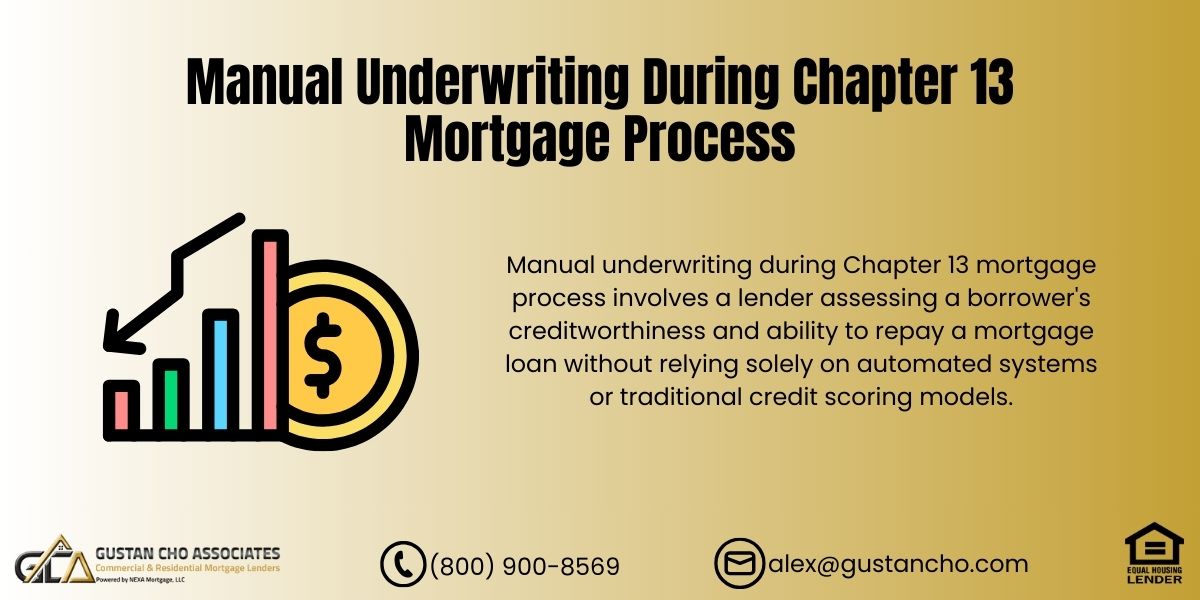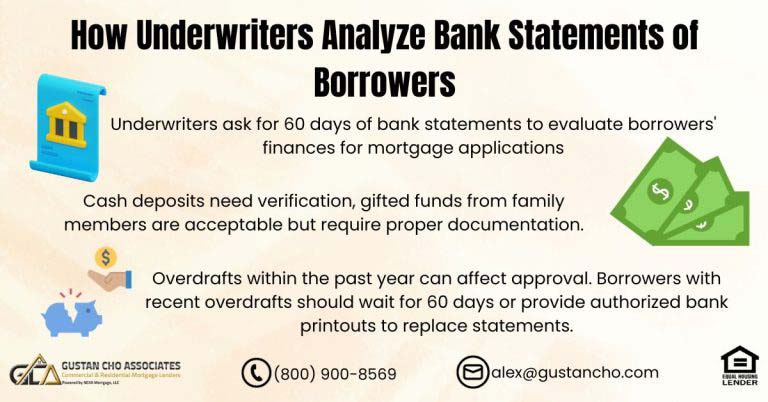In this article, we will discuss and cover manual underwriting during Chapter 13 mortgage process. Homebuyers can qualify for an FHA loan or VA loan while in an active Chapter 13 Bankruptcy repayment plan via manual underwriting. Manual underwriting is only allowed on FHA and VA loans. No other loan program permits manual underwriting. There is no huge difference between manual underwriting and automated underwriting system (AUS).
The only major difference between manual underwriting during Chapter 13 Mortgage Process versus automated underwriting system (AUS) is restrictions on debt-to-income ratios on manual underwrites.
Debt-to-income ratio caps depends on the number of compensating factors on manual underwriting. We will go over manual underwriting during Chapter 13 mortgage process as well as right after Chapter 13 Bankruptcy discharge. HUD and VA are the only two agencies that allow for manual underwriting. VA and FHA has similar guidelines on manual underwriting. Manual underwriting requires timely payments for the past 24 months on FHA loans. VA manual underwriting guidelines require 12 months of timely payments. In the following paragraphs, we will cover manual underwriting during Chapter 13 mortgage process.
How Long Does Manual Underwriting Take?
Manual underwriting during Chapter 13 mortgage process does not take much longer than an automated underwriting system (AUS) file. Most mortgage lenders who do manual underwriting on FHA and VA loans can zip right through a file just like an automated underwriting system file.
Since manual underwriting involves higher risk for the lender, borrowers in Chapter 13 bankruptcy may face higher interest rates or fees than borrowers with stronger credit profiles.
The only major difference between manual versus automated underwriting system approvals is the underwriter places more emphasis on the borrower’s ability to repay on manual underwriting. Also, there is a restriction on the maximum debt-to-income ratio cap on manual underwriting. The number of compensating factors determines the front-end and back-end debt-to-income ratio on manual underwriting.
Find A Lender For Your Mortgage Loans
Apply Online And Get recommendations From Loan Experts
How Does Manual Underwriting During Chapter 13 Mortgage Process Work
Manual underwriting during Chapter 13 mortgage process involves a lender assessing a borrower’s creditworthiness and ability to repay a mortgage loan without relying solely on automated systems or traditional credit scoring models. Chapter 13 is a reorganization bankruptcy where the debtor proposes a repayment plan to repay creditors over three to five years. Here’s how manual underwriting might come into play during this process:
Assessment of Financial Situation
Instead of relying solely on credit scores, the lender will closely examine the borrower’s financial situation. This includes reviewing income, expenses, assets, and liabilities.
Review of Chapter 13 Plan
Lenders will scrutinize the terms of the Chapter 13 repayment plan. They want to ensure that the borrower has been making timely payments to creditors and that the proposed mortgage payment fits within the budget outlined in the plan. Borrowers may be asked to provide extensive documentation to support their financial stability. This can include pay stubs, tax returns, bank statements, and documentation related to the Chapter 13 bankruptcy, such as court filings and the repayment plan.
Discretionary Decision Making on Manual Underwriting During Chapter 13
Manual underwriting allows lenders to exercise discretion in assessing the borrower’s loan repayment ability. They may consider factors such as the reason for bankruptcy, the borrower’s financial behavior before and during bankruptcy, and any extenuating circumstances. Manual underwriting requires timely payments in the past 24 months.
Manual underwriting typically involves more rigorous scrutiny than automated underwriting processes. Lenders may take extra steps to verify information and ensure the borrower meets their lending criteria.
Manual underwriting during the Chapter 13 mortgage process allows borrowers to demonstrate their ability to manage their finances responsibly despite past credit issues. However, borrowers must be prepared for a more intensive review process and potentially less favorable loan terms.
Best Manual Underwriting Mortgage Companies
Per HUD manual underwriting During Chapter 13 mortgage process, borrowers can qualify for FHA land VA loans during Chapter 13 Bankruptcy repayment period. Chapter 13 Bankruptcy does not have to be discharged to qualify for FHA and VA loans. Borrowers for manual underwriting during Chapter 13 bankruptcy should consult with specialized lenders.
Lenders specializing in manual underwriting during Chapter 13 Bankruptcy may have more flexibility in their underwriting criteria and be more willing to work with borrowers who don’t qualify for traditional mortgages.
Although HUD manual underwriting during Chapter 13 mortgage process allows borrowers to qualify for an FHA or VA loan on a home purchase or refinance, many mortgage companies will not allow this because of lender overlays. Lender overlays are additional mortgage guidelines above the minimum guidelines of HUD that lenders impose.
What Mortgage Programs Can You Do Manual Underwriting?
HUD and the VA are the only two agencies that allow borrowers in Chapter 13 Bankruptcy repayment plan to qualify for a mortgage with Trustee Approval on FHA and VA loans. HUD and VA are the only two loan programs that allow manual underwriting.
Some lenders specialize in providing mortgages to borrowers with past credit challenges, including those in Chapter 13 bankruptcy during repayment plan with no lender overlays.
Agency guidelines on FHA and VA loans for qualification requirements on manual underwriting are almost the exact same. So are the eligibility requirements to qualify for a mortgage during the Chapter 13 Bankruptcy repayment plan. Both FHA and VA loans do not have any waiting period requirements after the Chapter 13 Bankruptcy discharge date.
Do All Lenders Have The Same Manual Underwriting Guidelines?
All lenders need to meet minimum HUD Guidelines per HUD 4000.1 FHA Handbook. Lenders can have higher standards on FHA loans called lender overlays. Most lenders have lender overlays on government and conventional loans. Gustan Cho Associates is one of the very few lenders that have no lender overlays on government and conventional loans. We just follow the minimum HUD Mortgage Guidelines. We just follow the automated findings of the automated underwriting system (AUS). FHA and VA files that cannot get an AUS approval and get a refer/eligible per AUS can be manually underwritten. We have no other overlays. In this article, we will cover and discuss HUD Chapter 13 Manual Guidelines.
HUD Manual Underwriting During Chapter 13 Mortgage Process Versus Other Loan Programs
FHA and VA loans are the only loan programs that allow borrowers in an active Chapter 13 Bankruptcy Repayment plan to qualify for home loans. VA and HUD Chapter 13 Manual Guidelines are almost the same. Agency guidelines of the VA and HUD Chapter 13 manual guidelines allow borrowers to qualify for VA or FHA Loans during Chapter 13 repayment plan Trustee approval is required. Most Trustees will sign off on a home loan during Chapter 13 Bankruptcy repayment plan. This only holds true as long as the borrower is able to afford it.
Mortgage Approval After Chapter 13 Bankruptcy Discharge
Apply Online And Get recommendations From Loan Experts
Mortgage Approval After Chapter 13 Bankruptcy Discharge
There are no waiting period requirements to qualify for FHA or VA loans after the Chapter 13 Bankruptcy discharged date. For any Chapter 13 Bankruptcy discharge that has not been seasoned for at least 24 months, the VA or FHA file needs to be manually underwritten. Manual underwriting guidelines apply.
VA-FHA Manual Underwriting Guidelines
FHA and VA loans have almost identical manual underwriting guidelines. Automated findings of refer/eligible per AUS can be downgraded to manual underwriting on VA and FHA loans. Here are the manual underwriting guidelines:
- No late payments in the past 12 months
- Verification of rent required on all manual underwriting
- Borrowers without verification of rent and living with family to save money for the down payment and closing costs on the home purchase can complete a living-with-family rent-free letter
- This letter is provided by the lender
- If the borrower is in an active Chapter 13 Bankruptcy Repayment Plan, the Bankruptcy Trustee needs to approve the home purchase transaction
- There is no waiting period after the Chapter 13 Bankruptcy discharge date to qualify for VA and/or FHA Loans
- One or two late payments in the past 24 months is not always a deal killer with extenuating circumstances
- Manual Underwriting requires one month’s of reserves
- Reserves are one month’s principal, interest, taxes, and insurance
- Reserves need to be the borrower’s own funds and cannot be gifted
Debt-to-income ratio caps is dependent on the amount of compensating factors.
Debt-to-Income Ratio on Manual Underwriting Versus Compensating Factors
Debt-to-income ratio caps is limited on manual underwriting. Here are the maximum debt-to-income ratio requirements on manual underwrites:
- 31% front end and 43% back end with no compensating factors
- 37% front end and 47% back end with two compensating factors
- 40% front end and 50% back end with two compensating factors
Gustan Cho Associates allows up to 64% debt-to-income ratio on manual underwriting on VA loans with compensating factors and underwriter discretion.
What Are Compensating Factors on Manual Underwriting?
Compensating Factors are positive factors considered by mortgage lenders on manual underwriting during Chapter 13 mortgage process. Here are examples of compensating factors:
- 3 months of reserves
- Qualified income such as part-time income with at least one-year seasoning but not used in qualifying for the loan
- Larger down payment on a home purchase
- Habit and history of saving money
- Payment shock of less than 5% from renting to the new mortgage payment determined by rental verification
For more information on the contents of this article and/or other mortgage-related topics, please contact us at Gustan Cho Associates at 800-900-8569 or text us for a faster response. Or email us at gcho@gustancho.com. The team at Gustan Cho Associates are experts in manual underwriting during Chapter 13 mortgage process on FHA and VA loans.
Apply For Mortgage Loans During Chapter 13 Bankruptcy
Apply Online And Get recommendations From Loan Experts
Frequently Asked Questions About Manual Underwriting During Chapter 13:
Q: What is Manual Underwriting During Chapter 13 Bankruptcy?
A: Manual Underwriting During Chapter 13, a lender personally reviews your mortgage application instead of relying on a computer system. This is common when you’re in an active Chapter 13 repayment plan and want to get an FHA or VA loan.
Q: Can I Get a Mortgage While in an Active Chapter 13 Repayment Plan?
A: Yes, you can qualify for an FHA or VA loan during your Chapter 13 repayment plan through Manual Underwriting During Chapter 13. You’ll need approval from the bankruptcy trustee.
Q: How Does Manual Underwriting Differ from Automated Underwriting?
A: The main difference is that Manual Underwriting During Chapter 13 involves a lender closely reviewing your finances, while automated underwriting uses computer systems. Manual underwriting may have stricter debt-to-income ratio limits.
Q: What Are the Debt-to-Income Ratio Limits in Manual Underwriting During Chapter 13?
A: Debt-to-income ratios are capped based on compensating factors. Generally, it starts at 31% for housing expenses and 43% for total debts, but it can go higher if you have positive factors like extra savings.
Q: Do All Lenders Offer Manual Underwriting During Chapter 13 Bankruptcy?
A: No, not all lenders offer this option. Many have stricter rules called “lender overlays.” You’ll need to find a lender experienced in Manual Underwriting During Chapter 13 without these extra restrictions.
Q: Which Loan Programs Allow Manual Underwriting During Chapter 13?
A: Only FHA and VA loans permit Manual Underwriting During Chapter 13 bankruptcy. Other loan programs do not allow manual underwriting in this situation.
Q: How Long Does Manual Underwriting Take During Chapter 13 Bankruptcy?
A: It doesn’t take much longer than automated underwriting. Lenders experienced in Manual Underwriting During Chapter 13 can process your application efficiently.
Q: What Compensating Factors Can Help Me Qualify Through Manual Underwriting During Chapter 13?
A: Compensating factors include having savings equal to a few months of mortgage payments, a history of saving money, a larger down payment, or a low payment shock from renting to buying.
Q: Do I Need Trustee Approval to Get a Mortgage During Chapter 13 Bankruptcy?
A: Yes, you’ll need approval from your Chapter 13 bankruptcy trustee to proceed with a mortgage using Manual Underwriting During Chapter 13.
Q: Is There a Waiting Period After Chapter 13 Discharge to Qualify for an FHA or VA Loan?
A: No, there’s no waiting period after your Chapter 13 discharge to qualify for an FHA or VA loan through Manual Underwriting During Chapter 13.
This blog about “Manual Underwriting During Chapter 13 Mortgage Process” was updated on December 19th, 2024.










